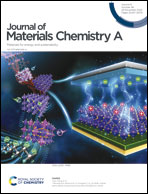Heterogeneous structured pomegranate-like Bi@C nanospheres for high-performance sodium storage†
Abstract
The optimized design of size effects and interface effects can enhance the electron/Na-ion migration kinetics for energy-storage materials. Herein, small-size pomegranate-like Bi@C nanospheres (PBCNSs) are synthesized via a simple method and used as the anode of sodium-ion batteries. The composite has a hierarchical structure with ultra-small Bi nanoparticles embedded within carbon spheres which enable fast kinetics and efficient alleviation of stress/strain from the electrodes, and the conductive carbon matrix provides an interconnected electron transportation pathway. Moreover, the hierarchical structure can efficiently prevent the aggregation and pulverization of Bi nanoparticles. The PBCNSs anode delivers excellent sodium-storage performance with an outstanding rate performance (400.3 mA h g−1 at 0.2 A g−1, 372.8 mA h g−1 at 25 A g−1) and long-term cycle stability (340 mA h g−1 after 16 000 cycles at a high current density of 20 A g−1). More importantly, even at a high mass loading of 11.33 mg cm−2, a stable reversible capacity of 327.2 mA h g−1 can be obtained. The mechanism of the high performance was studied by electrochemical measurement and computer simulation.



 Please wait while we load your content...
Please wait while we load your content...